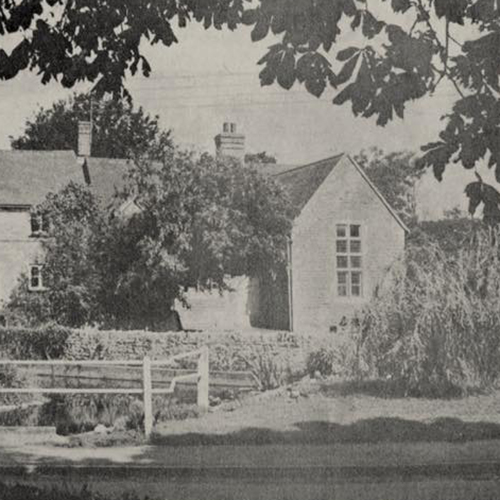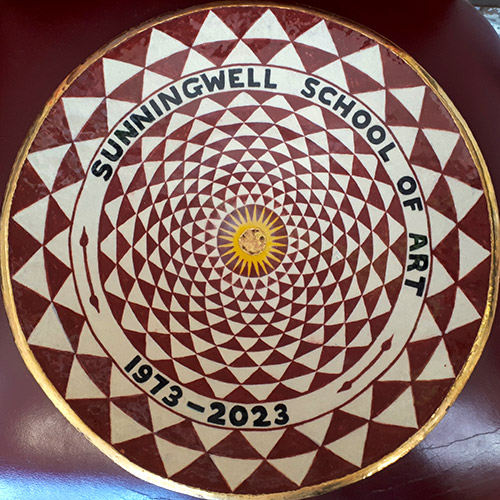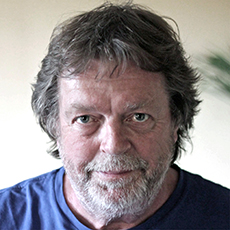The remarkable foresight and initiative that established Sunningwell School of Art in the old village school building was, in the first instance, the brainchild of two tutors at the then Oxford Polytechnic – the Canadian painter Duncan Killen of Boars Hill and Dr. Len McComb from London (later RA). Duncan recalled that it was Joe Passingham, a well-known local figure, who first advised him of the vacant former school. With encouragement from the local Rector, an approach was made to the County Council Education Department to see if it would be possible to lease the vacant Church of England school building.
This was approved and having acquired use of the building for a token rent in October 1973, further pioneer class tutors were enlisted, notably the potter Lesley Williams and artists John Newberry and Archie Utin and the embryo art school opened its doors. Founded largely on the proverbial wing and a prayer, financial and more general support essential to the school’s firm establishment was gradually given by a small number of dedicated local volunteers and well-wishers, the then Parish Clerk Harold Stainton, becoming one of the very first students and later a trustee until his death.
The school did not enjoy a truly firm footing until it acquired its own board of trustees, a steering committee and an experienced volunteer administrator – Dennis Williams to see to the finances and the day to day running of the school.
In its early years the school was particularly dependent upon the patronage of Blackwell Scientific Publications in the shape of Chief Executive Per Saugman, and that of Steve Crawley of Coleman Construction. Valuable additional support came from the district council, the Southern Arts Council and other generous benefactors, eager to see the school succeed.
By 1979 the school could boast of over 100 students, including a number of parishioners – local involvement being one of the desired aims of the school from its outset. By this time there were 7 tutors covering classes in drawing, painting, batik, watercolour painting, sculpture and pottery – the latter class, along with a drawing class, by then open to children.
Crisis struck in the same year when it became apparent that faced with the upkeep of a redundant school the owners of the building – the Sunningwell Poor’s Land Education Foundation – in cooperation with the County Council Education Department wished to dispose of the school and were preparing to place it on the open market. To counter this threat Blackwell Scientific as principal patrons generously offered a life-saving bid of £30,000 as a philanthropic gesture in order to purchase the school. However, this sum was insufficient as the school was likely to fetch nearly double that figure when offered for sale on the open market or by auction, as was required under the strict Charity Commission rules to which the Art School (by now a charity) was beholden.
Undaunted, a campaign was launched by Duncan Killen and Roger Wiggins to bring all the interested parties round to the wisdom of preserving the school in the interests of the community. As a result of correspondence, a petition and a public meeting with all the authorities involved – including the Church and Parish Council – full support for the Blackwell Scientific proposal was achieved. The the stumbling-block of the Charity Commission protocol remained: a Resolution from the public meeting was sent to the Charity Commissioners urging them to accept the offer from Blackwell Scientific.
Following an approach from the campaigners, local MP Airey Neave visited the school and subsequently, just days before his tragic death at the hands of the IRA, succeeded in persuading the Charity Commissioners that an exception to the rules governing the disposal of the school should be made in the interests of the local community, thus acceptance of the Blackwell scientific proposal was made possible. Thereafter the school was the beneficiary of a mere peppercorn rent of £1 per year from Blackwells who also agreed to share the running costs for 7 years along with construction firm Benfield and Loxley.
The saving of the school through the good offices of Per Saugman and Airey Neave is commemorated by the plaque erected in the main schoolroom which was unveiled on the 29th March, 1980 by Lady Airey Neave on the occasion of an exhibition of work by the school’s staff and students.
Having secured a firmer footing Sunningwell School of Art went on from strength to strength, an achievement that was to culminate in the Trustees finally being in a position to purchase the premises outright in June 2000.
Over fifty years on, the school now has around 30 of Oxfordshire’s best professional practicing artists educating over 400 students six days a week and is not only an established and respected bastion of the of the local community and a Mecca for those of artistic talent or aspirations from a wide area, but a shining example of what can be achieved through dedicated community involvement and the ethic of self-help.




